Morningstar Bakery is a new organic bakery specializing in gluten, wheat, and dairy free products. Demand for these bakery products has significantly increased in the last three years. Americans have recently been diagnosed with food allergies, making them more aware of this issue. Previously, there were no solutions available for people affected by these allergies. However, modifying their diet has become a manageable option. This is beneficial for individuals with allergies and for bakeries like Morningstar that specialize in these products.
Morningstar offers a variety of products. They have a selection of spelt breads, muffins, and pastries. Spelt is used because fewer people are allergic to this grain. Additionally, they provide yeast-free breads to cater to customers with yeast allergies. Vegans can enjoy their dairy-free muffins and pastries. Finally, Morningstar also offers egg-free breads, muffins, and pastries.
Morningstar focuses on three customer segments. The first is the Allergy group, which is growing at a rate of 15% per year and has 32,000 potential customers. The second segment is the Doctor group, which is also growing at 15% and has 14,200 potential customers. The third segment is the Dieters group, which consists of individuals making dietary modifications to lose weight. This niche is also growing at 15% and has 48,000 potential customers.
Morningstar recognizes the importance of human capital and has assembled a strong management team. Donna Sharp leads the team with 10 years of baking experience and 2 years of management experience. Donovan Bailey brings financial skills after a 15-year CPA career. Tara Juniper-Reid is responsible for marketing and has experience in her own PR firm. Lucy Hamilton, an assistant baker with over five years of experience, is also part of the team.
Morningstar is an exciting opportunity that offers fresh baked goods with spelt, yeast-free, dairy-free, and egg-free options. These products address the increasing need for allergen-free choices. As medical doctors become more aware of food allergies in the American population, the demand for these products is expected to grow exponentially. Profitability is projected to be achieved by month three. Morningstar’s strong management team, solid business model, and market-demanded products will facilitate quick market penetration and financial success.
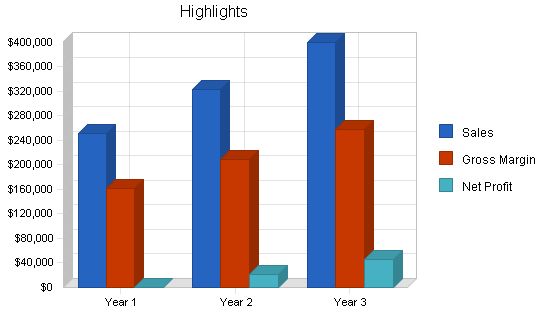
1.1 Objectives:
– Establish a working storefront for Morningstar bakery.
– Develop a strong presence in the community to support sales goals.
– Develop a full menu by the end of the second quarter.
1.2 Mission:
Morningstar Bakery aims to be a cornerstone in the community, creating a neighborhood atmosphere where customers feel comfortable and become regulars. We cater to allergy sufferers with our healthy, delicious baked goods. Our goal is fair and responsible profit to maintain long-term financial health and compensate owners and investors.
Morningstar Bakery is located in downtown [Name omitted] in a historical building. This downtown district is popular for its historical architecture, attracting weekenders, tourists, and downtown employees. The bakery sells non-wheat and other health-specific breads, sweets, and pastries every Tuesday through Sunday.
2.1 Company Ownership:
Morningstar Bakery is currently a sole proprietorship owned by Donna Sharp. Eventually, the company will apply to be incorporated.
2.2 Start-up Summary:
The primary expense to establish Morningstar Bakery is the mortgage loan of $175,000 to purchase the vacant space on [Name omitted] street. The building was previously used as a bakery, and we will buy the used equipment along with the space, which is included in the loan estimate. Donna Sharp will invest $7,500 of her savings to cover other start-up costs, including advertising brochures, bakery ingredients, insurance, and bakery accessories (paper bags, cartons, etc.).
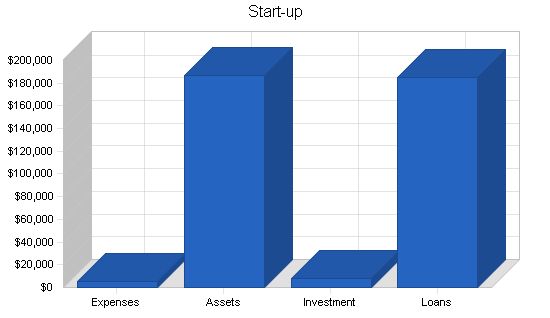
Morningstar Bakery specializes in providing non-gluten baked goods and pastries for diet-conscious and wheat-allergic consumers. We also accommodate common food allergies such as dairy, yeast, wheat, and eggs.
Our product offerings include:
– Spelt breads, muffins, and pastries: Spelt flour, a common wheat alternative, mimics the characteristics of wheat, resulting in baked goods with similar taste and consistency.
– Yeast-free breads: We offer a range of yeast-free breads for individuals with yeast allergies or those advised by their doctors to avoid yeast consumption.
– Dairy-free muffins and pastries: Most breads do not contain dairy, but muffins and pastries often require butter. To accommodate dairy allergies, we use a soy substitute.
– Egg-free breads, muffins, and pastries: Eggs are a common ingredient in muffins and pastries, but we use applesauce as a moist substitute.
Our target market comprises health-conscious individuals and those with common food allergies. This niche market is not adequately served by most bakeries, except for those catering to high-fiber diets.
Within our target market, we identify three key groups:
– The Allergy Group: Approximately one out of five people have a common food allergy, yet few bakeries cater to their needs.
– The Doctor Diet Group: Many individuals are advised by their doctors to avoid certain foods due to high cholesterol and blood pressure, as heart disease remains a significant health concern.
– The Diet Craze Group: The year 2000 witnessed the emergence of 20 new diet fads discouraging the consumption of certain foods like wheat and dairy. The best-selling health book on the New York Times list, "Blood Type Diet," encouraged the consumption of non-gluten flours like spelt and the avoidance of dairy. Although this target market is substantial, it is subject to fluctuations as individuals often cycle between different diets.
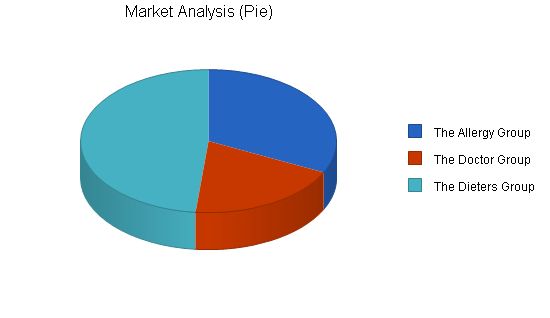
Potential Customers Growth Year 1 Year 2 Year 3 Year 4 Year 5 CAGR
The Allergy Group 15% 32,000 36,800 42,320 48,668 55,968 15.00%
The Doctor Group 15% 19,200 22,080 25,392 29,201 33,581 15.00%
The Dieters Group 15% 48,000 55,200 63,480 73,002 83,952 15.00%
Total 15.00% 99,200 114,080 131,192 150,871 173,501 15.00%
4.2 Target Market Segment Strategy
In our target market, we will focus on the “allergy group” as they are the most prevalent and steady customers. The “doctor diet group” and the ‘”diet craze” group will make up a smaller portion of our customers. We have not listed “regular customers” as a target group since those who do not fit into any of our groups are too varied to segment. We specifically fill the needs of the “allergy group” so we expect the most business from them.
Morningstar bakery competes in the Food Services Industry. In addition to other organic and non-wheat bakeries, it also competes with all restaurants, delis, bakeries, and supermarkets for a share of its customers’s food dollar. Morningstar is most concerned with competitors who differentiate their products and services with a healthy, organic focus. Because this group is so large, Morningstar has chosen to limit its analysis to other gluten-free bakeries.
4.3.1 Competition and Buying Patterns
Currently, there are two bakeries in town that provide non-wheat goods.
Great Harvest Bread Company
Strengths: Makes spelt bread, muffins, and cookies every Monday, Wednesday, and Friday. Well-established bakery in town. Sells breads in local grocery stores.
Weaknesses: Does not provide a wide selection of non-wheat goods. Furthermore, the texture and flavor of their spelt goods is very dense and flavorless. They use whole spelt bread which makes a denser, crumby consistency bread. We use white spelt in our spelt breads and other goods which has a texture and flavor similar to wheat.
The Sweet Life Patisserie
Strengths: Makes spelt bread, muffins, and brownies every day. Will make custom-ordered non-gluten cakes.
Weaknesses: Does not produce a wide selection or large quantity of non-wheat goods. Their main focus is wheat goods.
Strategy and Implementation Summary
Our strategy focuses on serving a niche market with quality goods. We are determined to become a part of the community – an establishment that becomes as much of the community as a church or local grocery store. To achieve these goals, we will provide:
-Friendly, neighborhood-feel atmosphere.
-Quality baked goods for everyone to enjoy at a fair price.
-Special diet menus in relation to the advice of local healthcare providers.
5.1 Sales Strategy
Our strategy focuses on building a customer base by providing a good customer experience. With the addition of the coffee bar and lunch menu in early spring, we hope to have customers make the bakery their one-stop destination for breakfast or lunch. In the summer, when we open the outdoor patio, more and more customers will make the bakery a destination for their lunches more often since the atmosphere will be pleasing.
We would also like to work closely with local doctors and elder care homes to bring in customers with health problems. We are already in negotiations with Dr. Goodman’s office to ensure referrals to the bakery for his patients.
To develop good business strategies, perform a SWOT analysis of your business. It’s easy with our free guide and template. Learn how to perform a SWOT analysis
5.1.1 Sales Forecast
Our sales forecast assumes the following changes:
-Bread sales in the summer months will be slightly higher since more people will be having BBQs and picnics requiring items such as hamburger and hotdog buns.
-Bread and pastry sales will be higher in November and December because of the food-oriented holidays.
-Coffee sales will be higher in winter months, and for summer months, sales of sodas and iced beverages will increase.
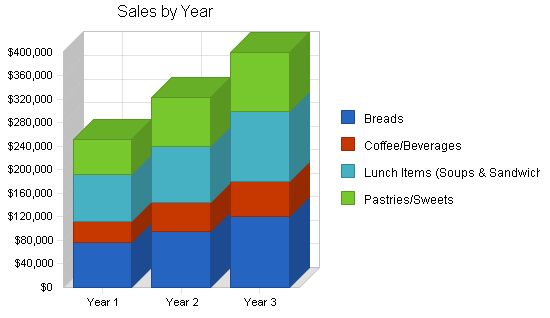
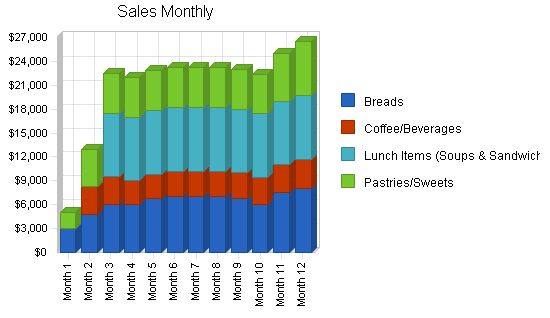
Sales Forecast
Sales
Year 1 Year 2 Year 3
Breads $75,900 $96,000 $120,000
Coffee/Beverages $36,400 $48,000 $60,000
Lunch Items (Soups & Sandwiches) $80,000 $96,000 $120,000
Pastries/Sweets $59,400 $84,000 $100,000
Total Sales $251,700 $324,000 $400,000
Direct Cost of Sales
Year 1 Year 2 Year 3
Breads $22,770 $28,800 $36,000
Coffee/Beverages $10,920 $14,400 $18,000
Lunch Items (Soups & Sandwiches) $32,000 $38,400 $48,000
Pastries/Sweets $23,760 $33,600 $40,000
Subtotal Direct Cost of Sales $89,450 $115,200 $142,000
5.2 Competitive Edge
Our competitive edge is our quality of goods. We use only organic flours of the highest quality to create incredible non-gluten goods that can’t be matched anywhere else in town. We also focus mainly on non-gluten goods. The other bakeries in town predominantly focus on wheat goods and occasionally use alternative flours as an afterthought.
5.3 Milestones
The table below displays the milestones that Morningstar Bakery aims to achieve in the first three years. Emphasis in the first year will be on advertising to establish Morningstar Bakery as a prominent business in town.
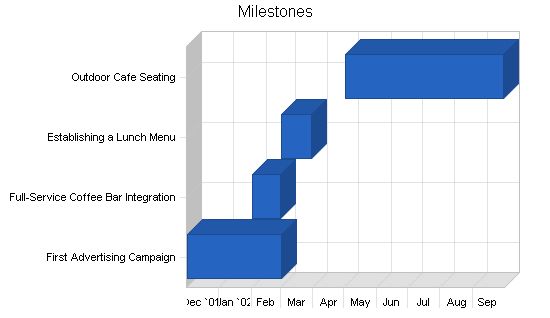
Donna Sharp, founder of Morningstar Bakery, brings experience as both a baker and an entrepreneur. She has over 10 years of baking experience and spent two years as an apprentice in a well-known Paris patisserie. As a teenager, she worked at her family’s general store, gaining experience in sales and marketing. In her last two years at the store, she was the general employee manager. Her responsibilities at the bakery will include employee hiring and training, head baker, and store management.
Donovan Bailey has successfully run his own CPA consulting firm for 15 years. His duties at Morningstar Bakery will include bookkeeping, inventory management, and stock fulfillment.
Tara Juniper-Reid runs her own PR company and will assist Morningstar Bakery with marketing campaigns part-time.
Lucy Hamilton has worked as a baker for over five years and will be the assistant baker. She will also manage the bakery shopping list.
Once the bakery is established and cash flow is steady, we plan to hire one person for counter help and another assistant baker. This will coincide with the opening of a lunch menu and coffee bar, which will require additional help.
The table below illustrates the needs of current employees and the integration of two more employees within three months of operation. These new hirings will align with the opening of the lunch menu and coffee bar.
– Donna Sharp – Head Baker: $24,000 (Year 1), $26,400 (Year 2), $29,040 (Year 3)
– Lucy Hamilton: $21,000 (Year 1), $23,100 (Year 2), $25,410 (Year 3)
– Tara Juniper-Reid – Part-time: $9,000 (Year 1), $9,900 (Year 2), $10,890 (Year 3)
– Counter Help – Full Time: $18,000 (Year 1), $19,800 (Year 2), $21,780 (Year 3)
– Assistant Baker – Part time: $9,000 (Year 1), $9,900 (Year 2), $10,890 (Year 3)
– Donovan Hamilton – Bookkeeper: $24,000 (Year 1), $26,400 (Year 2), $29,040 (Year 3)
The total number of people in the personnel plan is 6. The total payroll is $105,000 (Year 1), $115,500 (Year 2), $127,050 (Year 3).
In terms of the financial plan, we believe that even if the U.S. enters a recession, our business will not be significantly affected. Our products contribute to good health, and we operate in a niche market. Additionally, our breads and sweets are priced competitively.
The table below outlines general assumptions for the next three years.
– Plan Month: 1, 2, 3
– Current Interest Rate: 9.00%
– Long-term Interest Rate: 8.50%
– Tax Rate: 25.42% (Year 1), 25.00% (Year 2), 25.42% (Year 3)
– Other: 0
Our Break-Even Analysis includes the running costs of production, such as manufacturing ingredients (flour, sugar, yeast, butter), payroll, mortgage, utilities, and advertising. This analysis indicates that we will reach the break-even point each month.
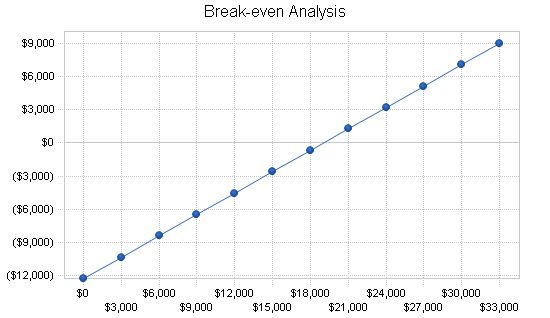
Break-even Analysis:
Monthly Revenue Break-even: $19,036.
Assumptions:
– Average Percent Variable Cost: 36%
– Estimated Monthly Fixed Cost: $12,271.
Projected Profit and Loss:
The table below displays the projected profit and loss for Morningstar Bakery.
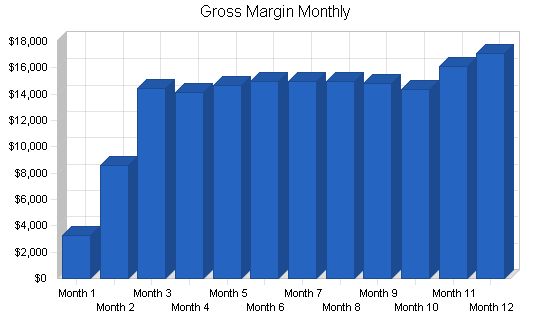
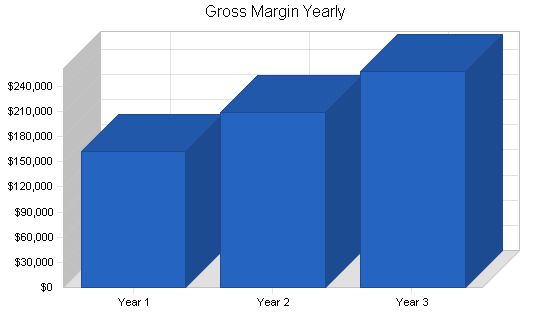
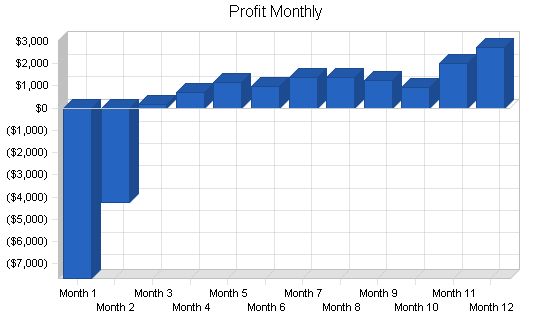
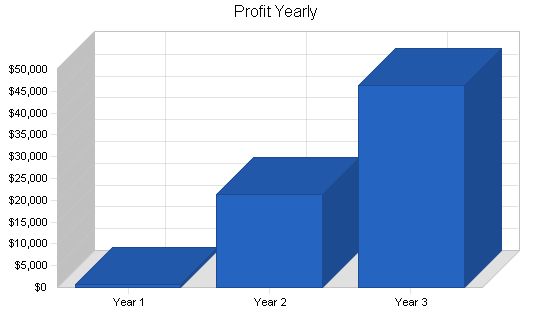
Pro Forma Profit and Loss:
Year 1 Year 2 Year 3
Sales $251,700 $324,000 $400,000
Direct Cost of Sales $89,450 $115,200 $142,000
Other $0 $0 $0
Total Cost of Sales $89,450 $115,200 $142,000
Gross Margin $162,250 $208,800 $258,000
Gross Margin % 64.46% 64.44% 64.50%
Expenses:
Payroll $105,000 $115,500 $127,050
Sales and Marketing and Other Expenses $13,040 $14,640 $16,640
Depreciation $3,492 $3,492 $3,492
Utilities $519 $600 $800
Insurance $1,800 $2,400 $2,800
Mortgage $10,800 $15,096 $15,096
Payroll Taxes $12,600 $13,860 $15,246
Other $0 $0 $0
Total Operating Expenses $147,251 $165,588 $181,124
Profit Before Interest and Taxes $14,999 $43,212 $76,876
EBITDA $18,491 $46,704 $80,368
Interest Expense $14,705 $14,705 $14,705
Taxes Incurred ($473) $7,127 $15,802
Net Profit $767 $21,380 $46,369
Net Profit/Sales 0.30% 6.60% 11.59%
7.4 Projected Cash Flow:
The chart below shows a healthy cash balance for the first three years, allowing the company to reinvest and grow.
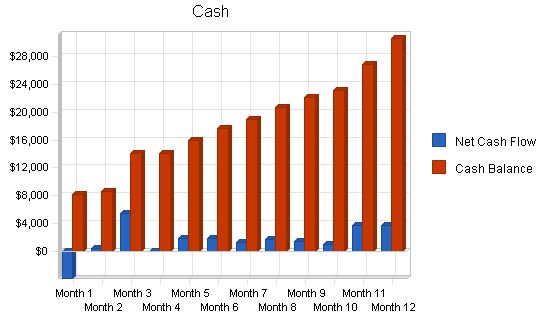
Pro Forma Cash Flow
| Pro Forma Cash Flow | |||
| Year 1 | Year 2 | Year 3 | |
| Cash Received | |||
| Cash from Operations | |||
| Cash Sales | $251,700 | $324,000 | $400,000 |
| Subtotal Cash from Operations | $251,700 | $324,000 | $400,000 |
| Additional Cash Received | |||
| Sales Tax, VAT, HST/GST Received | $0 | $0 | $0 |
| New Current Borrowing | $0 | $0 | $0 |
| New Other Liabilities (interest-free) | $0 | $0 | $0 |
| New Long-term Liabilities | $0 | $0 | $0 |
| Sales of Other Current Assets | $0 | $0 | $0 |
| Sales of Long-term Assets | $0 | $0 | $0 |
| New Investment Received | $0 | $0 | $0 |
| Subtotal Cash Received | $251,700 | $324,000 | $400,000 |
| Expenditures | Year 1 | Year 2 | Year 3 |
| Expenditures from Operations | |||
| Cash Spending | $105,000 | $115,500 | $127,050 |
| Bill Payments | $128,199 | $182,776 | $219,845 |
| Subtotal Spent on Operations | $233,199 | $298,276 | $346,895 |
| Additional Cash Spent | |||
| Sales Tax, VAT, HST/GST Paid Out | $0 | $0 | $0 |
| Principal Repayment of Current Borrowing | $0 | $0 | $0 |
| Other Liabilities Principal Repayment | $0 | $0 | $0 |
| Long-term Liabilities Principal Repayment | $0 | $0 | $0 |
| Purchase Other Current Assets | $0 | $0 | $0 |
| Purchase Long-term Assets | $0 | $0 | $0 |
| Dividends | $0 | $0 | $0 |
| Subtotal Cash Spent | $233,199 | $298,276 | $346,895 |
| Net Cash Flow | $18,501 | $25,724 | $53,105 |
| Cash Balance | $30,593 | $56,316 | $109,421 |
7.5 Projected Balance Sheet
The table below represents the financial position of the Morningstar Bakery at the end of each of the three upcoming fiscal years.
Pro Forma Balance Sheet
| Pro Forma Balance Sheet | |||
| Year 1 | Year 2 | Year 3 | |
| Assets | |||
| Current Assets | |||
| Cash | $30,593 | $56,316 | $109,421 |
| Other Current Assets | $0 | $0 | $0 |
| Total Current Assets | $30,593 | $56,316 | $109,421 |
| Long-term Assets | |||
| Long-term Assets | $175,000 | $175,000 | $175,000 |
| Accumulated Depreciation | $3,492 | $6,984 | $10,476 |
| Total Long-term Assets | $171,508 | $168,016 | $164,524 |
| Total Assets | $202,101 | $224,332 | $273,945 |
| Liabilities and Capital | Year 1 | Year 2 | Year 3 |
| Current Liabilities | |||
| Accounts Payable | $14,241 | $15,093 | $18,336 |
| Current Borrowing | $0 | $0 | $0 |
| Other Current Liabilities | $12,000 | $12,000 | $12,000 |
| Subtotal Current Liabilities | $26,241 | $27,093 | $30,336 |
| Long-term Liabilities | $173,000 | $173,000 | $173,000 |
| Total Liabilities | $199,241 | $200,093 | $203,336 |
| Paid-in Capital | $7,500 | $7,500 | $7,500 |
| Retained Earnings | ($5,408) | ($4,641) | $16,740 |
| Earnings | $767 | $21,380 | $46,369 |
| Total Capital | $2,859 | $24,240 | $70,609 |
| Total Liabilities and Capital | $202,101 | $224,332 | $273,945 |
| Net Worth | $2,859 | $24,240 | $70,609 |
7.6 Business Ratios
Business ratios for the years of this plan are shown below. Industry profile ratios based on the Standard Industrial Classification (SIC) code 5461, Retail Bakeries, are shown for comparison.
Ratio Analysis
| Ratio Analysis | ||||
| Year 1 | Year 2 | Year 3 | Industry Profile | |
| Sales Growth | 0.00% | 28.72% | 23.46% | 2.58% |
| Percent of Total Assets | ||||
| Other Current Assets | 0.00% | 0.00% | 0.00% | 29.82% |
| Total Current Assets | 15.14% | 25.10% | 39.94% | 55.20% |
| Long-term Assets | 84.86% | 74.90% | 60.06% | 44.80% |
| Total Assets | 100.00% | 100.00% | 100.00% | 100.00% |
| Current Liabilities | 12.98% | 12.08% | 11.07% | 25.40% |
| Long-term Liabilities | 85.60% | 77.12% | 63.15% | 23.07% |
| Total Liabilities | 98.59% | 89.19% | 74.23% | 48.47% |
| Net Worth | 1.41% | 10.81% | 25.77% | 51.53% |
| Percent of Sales | ||||
| Sales | 100.00% | 100.00% | 100.00% | 100.00% |
| Gross Margin | 64.46% | 64.44% | 64.50% | 36.64% |
| Selling, General & Administrative Expenses | 64.14% | 57.51% | 52.56% | 23.68% |
| Advertising Expenses | 4.13% | 3.70% | 3.50% | 1.65% |
| Profit Before Interest and Taxes | 5.96% | 13.34% | 19.22% | 1.92% |
| Main Ratios | Personnel Plan:
Donna Sharp – Head Baker, 0%, $2,000, $2,000, $2,000, $2,000, $2,000, $2,000, $2,000, $2,000, $2,000, $2,000, $2,000, $2,000 Lucy Hamilton, 0%, $1,750, $1,750, $1,750, $1,750, $1,750, $1,750, $1,750, $1,750, $1,750, $1,750, $1,750, $1,750 Tara Juniper-Reid – Part-time, 0%, $750, $750, $750, $750, $750, $750, $750, $750, $750, $750, $750, $750 Counter Help – Full Time, 0%, $1,500, $1,500, $1,500, $1,500, $1,500, $1,500, $1,500, $1,500, $1,500, $1,500, $1,500, $1,500 Assistant Baker – Part time, 0%, $750, $750, $750, $750, $750, $750, $750, $750, $750, $750, $750, $750, $750 Donovan Hamilton – Bookkeeper, 0%, $2,000, $2,000, $2,000, $2,000, $2,000, $2,000, $2,000, $2,000, $2,000, $2,000, $2,000, $2,000 Total People, 6, 6, 6, 6, 6, 6, 6, 6, 6, 6, 6, 6, 6 Total Payroll, $8,750, $8,750, $8,750, $8,750, $8,750, $8,750, $8,750, $8,750, $8,750, $8,750, $8,750, $8,750, $8,750 General Assumptions: Plan Month, 1, 2, 3, 4, 5, 6, 7, 8, 9, 10, 11, 12 Current Interest Rate, 9.00%, 9.00%, 9.00%, 9.00%, 9.00%, 9.00%, 9.00%, 9.00%, 9.00%, 9.00%, 9.00%, 9.00%, 9.00% Long-term Interest Rate, 8.50%, 8.50%, 8.50%, 8.50%, 8.50%, 8.50%, 8.50%, 8.50%, 8.50%, 8.50%, 8.50%, 8.50%, 8.50% Tax Rate, 30.00%, 25.00%, 25.00%, 25.00%, 25.00%, 25.00%, 25.00%, 25.00%, 25.00%, 25.00%, 25.00%, 25.00%, 25.00% Other, 0, 0, 0, 0, 0, 0, 0, 0, 0, 0, 0, 0, 0 Pro Forma Profit and Loss: Sales, $5,000, $12,900, $22,500, $22,000, $22,800, $23,200, $23,200, $23,200, $23,000, $22,400, $25,000, $26,500 Direct Cost of Sales, $1,700, $4,330, $8,050, $7,900, $8,140, $8,260, $8,260, $8,260, $8,200, $8,020, $8,900, $9,430 Other, $0, $0, $0, $0, $0, $0, $0, $0, $0, $0, $0, $0, $0 Total Cost of Sales, $1,700, $4,330, $8,050, $7,900, $8,140, $8,260, $8,260, $8,260, $8,200, $8,020, $8,900, $9,430 Gross Margin, $3,300, $8,570, $14,450, $14,100, $14,660, $14,940, $14,940, $14,940, $14,800, $14,380, $16,100, $17,070 Gross Margin %, 66.00%, 66.43%, 64.22%, 64.09%, 64.30%, 64.40%, 64.40%, 64.40%, 64.35%, 64.20%, 64.40%, 64.42% Expenses: Payroll, $8,750, $8,750, $8,750, $8,750, $8,750, $8,750, $8,750, $8,750, $8,750, $8,750, $8,750, $8,750 Sales and Marketing and Other Expenses, $1,820, $1,820, $1,820, $720, $720, $1,220, $720, $720, $720, $720, $1,020, $1,020 Depreciation, $291, $291, $291, $291, $291, $291, $291, $291, $291, $291, $291, $291 Utilities, $50, $50, $48, $45, $45, $35, $35, $35, $35, $45, $48, $48 Insurance, $150, $150, $150, $150, $150, $150, $150, $150, $150, $150, $150, $150 Mortgage, $900, $900, $900, $900, $900, $900, $900, $900, $900, $900, $900, $900 Payroll Taxes, 12%, $1,050, $1,050, $1,050, $1,050, $1,050, $1,050, $1,050, $1,050, $1,050, $1,050, $1,050, $1,050 Other, $0, $0, $0, $0 Pro Forma Cash Flow |
|||
| Month 1 | Month 2 | Month 3 | Month 4 | Month 5 | Month 6 | Month 7 | Month 8 | Month 9 | Month 10 | Month 11 | Month 12 | |
| Cash Sales | $5,000 | $12,900 | $22,500 | $22,000 | $22,800 | $23,200 | $23,200 | $23,200 | $23,000 | $22,400 | $25,000 | $26,500 |
| Subtotal Cash from Operations | $5,000 | $12,900 | $22,500 | $22,000 | $22,800 | $23,200 | $23,200 | $23,200 | $23,000 | $22,400 | $25,000 | $26,500 |
| Sales Tax, VAT, HST/GST Received | 0.00% | $0 | $0 | $0 | $0 | $0 | $0 | $0 | $0 | $0 | $0 | $0 |
Pro Forma Balance Sheet
| Month 1 | Month 2 | Month 3 | Month 4 | Month 5 | Month 6 | Month 7 | Month 8 | Month 9 | Month 10 | Month 11 | Month 12 | ||
| Current Assets | |||||||||||||
| Cash | $8,222 | $8,607 | $14,075 | $14,064 | $15,868 | $17,687 | $18,980 | $20,635 | $22,093 | $23,052 | $26,828 | $30,593 | |
| Other Current Assets | $0 | $0 | $0 | $0 | $0 | $0 | $0 | $0 | $0 | $0 | $0 | $0 | |
| Total Current Assets | $8,222 | $8,607 | $14,075 | $14,064 | $15,868 | $17,687 | $18,980 | $20,635 | $22,093 | $23,052 | $26,828 | $30,593 | |
| Long-term Assets | |||||||||||||
| Total Long-term Assets | $175,000 | $174,709 | $174,418 | $174,127 | $173,836 | $173,545 | $173,254 | $172,963 | $172,672 | $172,381 | $172,090 | $171,799 | $171,508 |
| Total Assets | $187,092 | $182,931 | $183,025 | $188,202 | $187,900 | $189,413 | $190,941 | $191,943 | $193,307 | $194,474 | $195,142 | $198,627 | $202,101 |
Hello!
I’m Andrew Brooks, a seasoned finance consultant from the USA and the mind behind phonenumber247.com.
My career is built on a foundation of helping individuals and businesses thrive financially in an ever-changing economic landscape. At phonenumber247.com, my aim is to demystify the complex world of finance, providing clear, actionable advice that can help you navigate your financial journey with confidence. Whether it’s personal finance management, investment strategies, or understanding the nuances of market dynamics, I’m here to share insights and tools that can propel you towards your financial goals.
Welcome to my digital space, where every piece of advice is a step closer to financial clarity and success!
